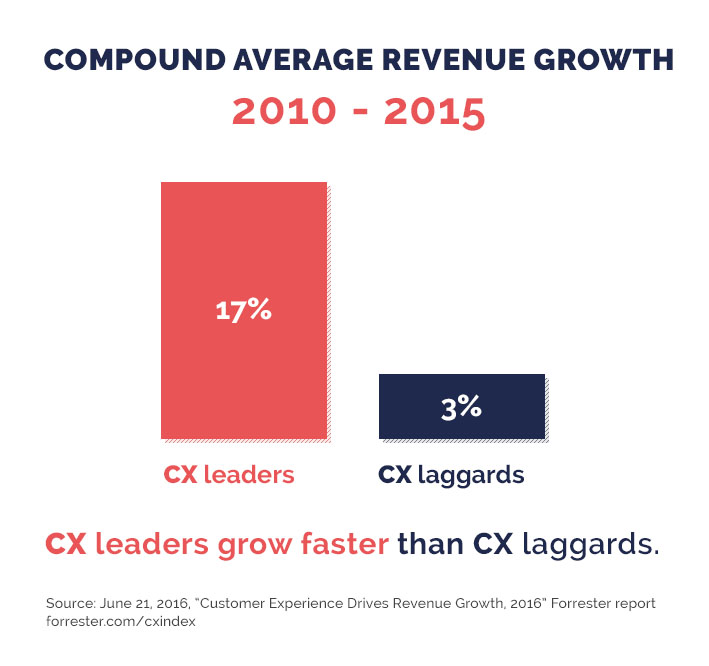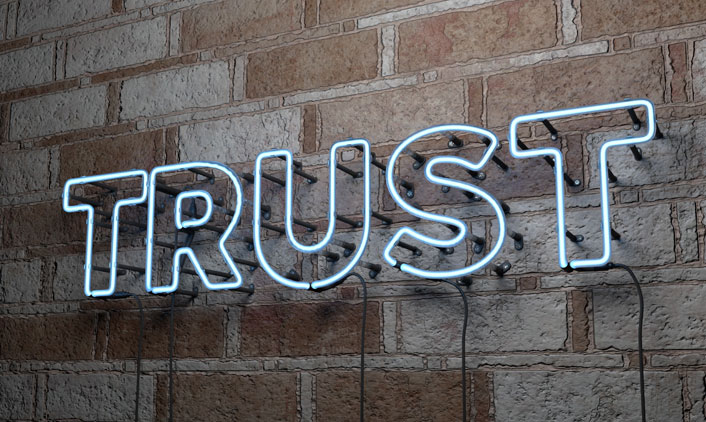Customer experience has emerged as one of the major business trends in recent years. As a discipline, it’s still in its infancy, but its increasing importance is hard to ignore.
And it’s not just because organisations want to provide better customer service, it’s driven by growing evidence that CX-led businesses deliver higher revenues. For example, a 2016 Forrester study showed that leaders in CX reported significantly higher revenue than CX laggards.

For most new and emerging businesses, CX may seem like something that’s for the big end of town. But the truth is that CX is your biggest opportunity to truly disrupt your sector.
What is CX?
CX is the sum of the interactions your customers have with your business, brand and product or service.
Think of your own interactions with brands like Apple. Apple, a technology business, provides education, technical support and free servicing in its retail stores. Apple’s products are the least of its differentiators. It now looks to multiple customer interactions to prove its relevance and retain your loyalty. This extended CX means that if you buy Apple, you most likely buy everything Apple – phone, tablet, laptop – and has helped Apple become one of the top 10 companies in the world.
Now think of the big 4 Australian banks. Theoretically, all of them have products that meet all of your financial services needs. Mortgages, everyday banking, insurance, advice – it’s all there. But how many of you have all your financial needs with your retail bank?
There are many reasons why this is very unlikely to be the case, but one of the main causes is the lack of a single view of customer. The retail banks in Australia have so many legacy systems and platforms across so many products that they don’t know you, they don’t know your needs and most likely, they don’t provide a CX that’s going to ensure you remain loyal.
Now this doesn’t mean that they aren’t successful – our banks are amongst the most profitable in the world. But it does mean that Fintechs, starting from scratch, have a killer advantage.
Why CX can be your biggest disruptor
You have the advantage of building a customer-led business from the start. The established firms against which you’re competing are product-led, meaning that their businesses have been built around their product set. Their results, organisational structures and remuneration are all based on products and the income from those products.
Sure, they’ll say they’re customer led. They’ll even send you a survey after you contact their call centre (how many of you actually stay on the line?). But the reality is most are struggling with how to create a customer-led culture. It’s hugely expensive and a significant challenge.
Fintechs, however, have none of those legacy issues. You have a great idea, most likely based on a clear customer need. You have the technical knowhow to deliver the product and you probably, hopefully, have some clients with whom you can test and learn.
The ability to deliver your product or service in a way that aligns with your customers’ needs is a once in a lifetime opportunity to truly disrupt your sector.
You have the perfect scenario to build the foundations early and economically, foundations that if applied correctly will drive exponential growth.
How you can build a customer-led business
The foundations of a customer-led business can be built by focusing on three core activities:
- Know your customers
- Focus on UX
- Automate early
Know your customers
Knowing your customers seems like an obvious exercise, but you’d be surprised how few companies have customer listening programs in place. You’d be even more surprised as to how many new and emerging businesses don’t put the customer at the heart of their initial MVP site and offer.
One of the main issues is that without customers, how do you find out what emotional and rational needs your product or service meets? Without that knowledge, how are you going to build a CX that will deliver engagement and ultimately sales?
The answer lies in solutions like Yell’s Proven Customer Vision (PCV) program. The PCV delivers insights into customer needs through customer interviews and research, creating personas and user journeys, which are then matched with business priorities to deliver a plan of action.
For Fintechs, this sort of activity is essential in understanding your audiences, how to meet their needs and how to reach them.
Focus on UX
User experience, or UX, like iX, is a subset of CX. There’s lots of X’s there, so to keep it simple, think of it like this:
- CX is organisational – is about culture, systems and interactions.
- iX is transactional – iX looks at your interactions; your digital and marketing channels, stores, call centres – how your customers interact and exchange value with your brand.
- UX is functional – your digital user experience, this is the layer of design and functionality that allows your audiences to meet their needs, quickly and simply.
For Fintechs, your UX is for all intents and purposes your CX, in that the majority of the experience is completed online. When done well, it can allow you to gain trust and most importantly gain advocates.
One company who has done an excellent job in delivering a seamless UX across multiple devices and even their core POS product is Square. Square has done such a good job delivering an effective CX that a recent Accenture survey found that 50% of respondents would bank with Square if they offered banking services.
Think about it. Because of its excellent UX and CX customers would buy additional services that aren’t even offered by that firm. That’s the power of customer focused UX.
Automate early
One of the key goals of an emerging business is to win an audience. Investment will need to be made in gaining initial awareness, that’s a fact. You will need to pay to get your message in front of potential customers, it’s not a case of ‘if you build it they will come’.
While many Fintechs acknowledge this issue, they don’t often consider ‘advertising’ as part of their customer experience. Remember, when we defined CX earlier, it’s about ALL of your customers’ touchpoints with your brand, including those initial encounters with your promotional messages.
What this means in practical terms is including your promotional activities in your user journey planning. How you take your audience from being made aware of your offer to converting them online may be a simple, or multi-step process. Either way, it’s going to require you to continue the conversation with your audience, post that initial engagement.
This means is that you should look at capturing their details at an early stage – via expressions of interest or opt-in content – and implement marketing automation to keep them warm from launch.
This may sound daunting and expensive and yes, it can be, but there are cost effective tools out there that can facilitate the automation, like Mailchimp and GetResponse. Emerging businesses may get sold the concept of a Marketo, or Hubspot, but realistically, unless you have contact lists in the thousands and multiple user scenarios, they are very unlikely to deliver ROI at this stage.
The main investment will come from the time spent building a strategy and putting budget aside to create regular content – something you should be considering even without automation to help organic search engine ranking.
By establishing automation right from the start, it will help you deliver a customer experience that allows you to continue the conversation with your audience. If done well, it should also encourage an increasing number of conversions, with automation taking your audiences through their journey to purchase/uptake of your offer.
And most importantly, it will mean that the audiences you’ve spent money attracting will be converted through an established, automated process, rather than having to spend advertising dollars attracting them back to the site each time.








